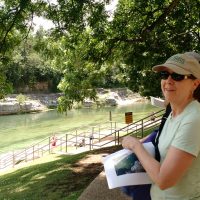Field Trip During International Karst Conference Looks at Science Behind Barton Springs
May 26, 2017

When an international group of scientists came to the Jackson School of Geosciences for a conference, they did what many others do when taking a trip to Austin: paid a visit to Barton Springs.
The beloved swimming hole is an oasis in the Texas heat, with the temperature of its spring-fed water maintaining a chilly 68 degrees Fahrenheit year round. The scientists, here for the Karst Record Conference, took a closer look at how Barton Springs fits into a larger Edward’s Aquifer system, a vital water resource for Central Texas.

Jay Banner, the director of the Jackson School Environmental Science Institute, and Kathleen Johnson, a professor at the University of California Irvine co-convened the four-day conference, which was packed with scientific talks and two poster sessions. Attendees had the chance to get some fresh air during a mid-conference field trip to either Barton Springs or Westcave, both beloved karst features of the Texas Hill Country. Karst is a geological term for landscapes made up of rocks that are easily eroded by water—such as limestone and dolomite—and full of underground drainage features, like caves and sinkholes.

MaryLynn Musgrove, a USGS hydrologist at the Texas Water Science Center, guided the group through the spring’s features. She said that while the spring is a relatively small part of the Edward’s Aquifer, it plays an important role in the local community and ecology alike.
“It’s a minor karst feature, but it’s in a unique urban setting. Its status as a pubic, unchlorinated spring-fed swimming hole makes it the jewel of Austin,” Musgrove said. “Understanding its hydrogeology is important to us. It’s also important to the endemic salamanders.”
The salamanders—the Barton Springs Salamander and the Austin Blind Salamander—are both endangered species, a designation that marks the spring as a “critical habitat” zone that must be protected and managed. This designation has helped promote close monitoring—all while about 800,000 people a year visit the spring.

But the famous pool is just part of the story. Barton Springs is actually a spring complex with four distinct water outlets called orifices where water flows from the aquifer to the surface. Two of the outlets, Eliza Spring and Zenobia Spring, are set aside as undisturbed habitats for the endangered salamanders, so swimming is verboten. Upper Spring, located a few minutes hike above the main spring, is the only orifice left in its natural state, with water bubbling up from the ground and flowing into the nearby Barton Creek. The main spring—also known as Parthenia Spring—is by far the largest, and deepest of the springs, with water flowing primarily from a large fault near the middle of the pool at an average rate of 1.7 cubic meters per second. Though at our visit on Tuesday, it was about double that.


The names of three of the springs—Eliza, Zenobia and Parthenia—honor the daughters of William “Uncle Billy” Barton, who bought the land where the springs are located in 1837. Andrew Jackson Zilker, the last private owner of the springs, donated the springs to the city of Austin in 1928. He later gifted land north of the springs, which became Zilker park.
Five local creeks provide the majority of the water that flows into the springs, Musgrove said, allowing researchers to monitor the spring’s water before and after it flows through the aquifer and into the springs.
“Barton Springs is an ideal natural karst laboratory,” Musgrove said. “There are five inputs into the aquifer and one major discharge point.”

Corinne Wong, an assistant professor at Boston College, utilized this “natural lab” while earning her master’s and Ph.D. at the Jackson School. Though her research primarily centered on the nearby Natural Bridge Cavern with Jay Banner, she co-authored research investigating the water quality of Barton Springs and received a Barton Springs Edwards Aquifer Conservation District Groundwater Stewardship Award for research on the potential for flow between the Edwards and Middle Trinity aquifers. She shared the award with Banner, who was her adviser, and then-graduate student Jenna Kromann. Back in Austin for the karst conference, she was able to lead other researchers through her old stomping grounds at the springs.

After hiking around the entire spring complex, the group returned to the Main spring to take a dip in the cool water—though most only got as far as their feet. Conference attendee Sarah Truebe, Director of Community Engaged Learning in Environmental Sustainability at Stanford University, said the experience was a nice excursion from the conference halls, but that she was excited for the next day of scientific talks back at campus.
“So far, every talk has something interesting,” she said.
